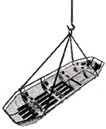 Over half of the workers who die in confined spaces are trying to rescue another worker and succumb to invisible gases or a lack of oxygen. The type of respiratory protection that employers and firefighters use during a rescue can literally mean life or death.
Over half of the workers who die in confined spaces are trying to rescue another worker and succumb to invisible gases or a lack of oxygen. The type of respiratory protection that employers and firefighters use during a rescue can literally mean life or death.
Confined spaces need not be small, and utility contractors deal with them regularly. Below-grade vaults and pipes are among the most common confined spaces. But any space that has limited entry and exit, or lacks natural ventilation, can be considered a risk. Workers must be trained not to focus only on the "entry," or they may not recognize that a large space is also potentially hazardous.
 |
| Rope entry is used in Atlanta-area rescue training. (Photo courtesy of American Society of Safety Engineers/Georgia Chapter) |
The U.S. Occupational Safety and Health Administration revised a federal confined space standard in 1998 so airline-escape, self-contained breathing equipment could be used where appropriate, in addition to positive-pressure self-contained breathing equipment with at least 30 minutes of air, says Timothy Kearney. He is vice president of The Argus Group, a safety products manufacturer in Chesterfield Township, Mich. Escape-type devices often are simply air bottles with a 10-minute air supply connected to a plastic hood, says OSHA.
| How to Save a Life |
|
|
| |
|
|
OSHA had previously written that the use of alternative types of respirators must be carefully weighed and that a rescuers air supply must be independent from the source used by the victim. It also stipulated that the volume of the air source for rescuers should be about twice what is estimated to finish the rescue operation, says Kearney. There are many other considerations, including proper training for escape and the close attention of a monitor outside the confined space.
Self-rescue training can teach employees to escape from danger, says Michael R. Roop of MRE Training & Consulting, Richmond, Texas. Trained workers should vacate any space in which they detect a strange odor, which could be a lethal gas, says Roop. They should also exit if they feel weak or light-headed, symptoms that could indicate oxygen deprivation.
A properly trained attendant outside a confined space is the next line of defense, especially if the monitor isnt given other duties that could be distracting, says the National Institute for Occupational Safety & Health. By paying attention, the attendant may recognize odd be-havior in the victim and order him or her to escape, says Roop. The odd behavior could indicate dangerous gases or a lack of oxygen.
Owners have a special role in identifying confined spaces, says Ron Smith, an Orlando, Fla., firefighter who is a member of a special rescue unit. Knowing what risks employees will face in a confined space is the first step in developing and executing a good safety and rescue plan. Central Florida is home to several large theme parks and one of them has identified more than 3,000 confined spaces on its property, says Smith. A processing plant for computer chips may use many unusual gases, he adds. OSHA requires that the "host employer" of a confined space must provide a level of rescue personnel "on a sliding scale" to the number of workers needed for the tasks to be performed in the confined space.
|


Post a comment to this article
Report Abusive Comment